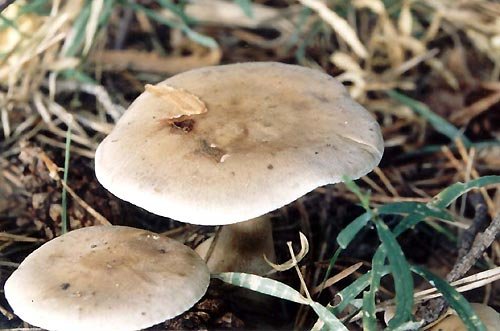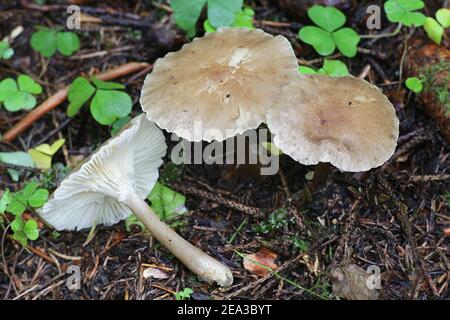Club-footed warbler (Ampulloclitocybe clavipes)
- Division: Basidiomycota (Basidiomycetes)
- Subdivision: Agaricomycotina (Agaricomycetes)
- Class: Agaricomycetes (Agaricomycetes)
- Subclass: Agaricomycetidae (Agaricomycetes)
- Order: Agaricales (Agaric or Lamellar)
- Family: Hygrophoraceae (Hygrophoraceae)
- Genus: Ampulloclitocybe
- Type: Ampulloclitocybe clavipes

Club-footed warbler (lat. Ampulloclitocybe clavipes) is a species of fungi in the Hygrophoraceae family. Previously, it was classified as a member of the Ryadovkovye family (Tricholomataceae).
Hat:
Diameter 4-8 cm, convex in youth, with age it opens to prostrate and even funnel-shaped, sometimes with a tubercle in the center. The color is indefinitely gray, brownish, the edges are usually much lighter. The flesh of the cap is friable, hygrophanous (very watery in wet weather), may emit a strong sweet smell (or may not emit).
Records:
Medium frequency, strongly descending along the stem, white when young, then becoming light cream.
Spore powder:
White.
Leg:
3-9 cm tall, solid, usually strongly expanding towards the base, club-shaped, occasionally almost cylindrical, smooth or slightly fibrous, pubescent at the base. The thickness of the stem in the upper part is 0,5-1 cm, in the lower part 1-3,5 cm. The color of the stem changes with age from almost white to brownish-gray, almost the color of the cap. The flesh of the leg is whitish, friable, hygrophanous, fibrous.
Spread:
The clubfoot talker occurs from mid-July to mid-October in forests of various types, obviously preferring pine from coniferous trees, and birch from deciduous trees; during the period of the most active fruiting (end of August – beginning of September) grows very abundantly, in large groups.
Similar species:
The club-shaped leg and deeply descending plates make it easy to distinguish the clubfoot talker from other gray fleshy mushrooms – from the smoky govorushka (Clitocybe nebularis), soap row (Tricholoma saponaceum) and others.
Edibility:
It is believed edible mushroom very low quality.










